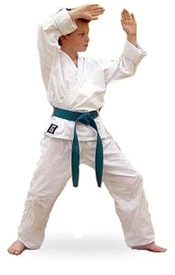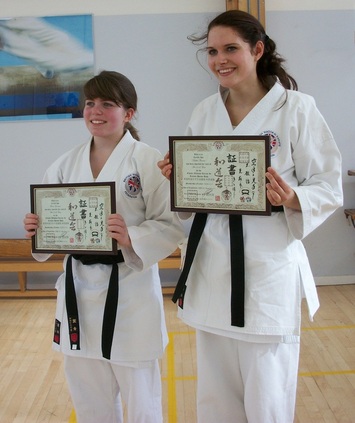Gradings, Improvement and the Relationship with the Young Student.
Junior Students
In British Wadokai we try and include many junior students into membership. However, by personal experience, we must consider just three types of junior, if under the age of 9 or 10, etc.
Criteria 1: Firstly, we have the dedicated [few] who enjoy their karate and are enthusiastic about progression. These students normally go through and become very proficient and achieve many goals along the way through the various ranks. They are very responsive to commands and instructions and learn and practise hard, especially at home – Like I say, the ‘few’ (as I only know of about half a dozen in all the years I have been teaching).
Criteria 2: Secondly, we have the ‘grade-grabbers’, those who are there just to get belts, although have little interest in working hard to achieve those grades. These students, although seem keen at first slowly slip into Criteria 3.
Criteria 3: Thirdly, we have the reluctant ones, who don’t really want to be there and spend the majority of the session being reprimanded for infringements in dojo etiquette and disruption with other members. These students have either been ‘forced’ to attend, to ‘accompany’ other members of the family, or simply deposited there as a means of cheap child-minding while the parents go up the pub or go shopping (or simply just to have a peaceful hour or two at home).
When I first greet a child to the Dojo, ensuring that the parent is present (of course), I ask why they are here. At first we may get the correct responses, such as they would like to pursue a martial-art, etc. However, many times I have had parents intervene, and answer on the child’s behalf, with, “He likes kicking the sofa, so I thought he may enjoy karate!”
Either way, as accommodating instructors as we are, we very often give the child the ‘benefit of the doubt’; and allow them to train. However, after a time (some longer than others) we can usually detect the ones that really want to be there and those who are there because they are ‘forced’ to attend. Noticeable symptoms include; class disruption, lack of learning, lack of enthusiasm, easily distracted, refuse to train at home to practise what they have learned (so they don’t need to be continually re-taught the same things), etc., etc.
When it gets to this point I usually suggest to the parents that they are now wasting their money and (more importantly) wasting my time; so politely asking them to take their child away to take up another activity,. Such as street-graffiti or get back on the Play-station where they would prefer to belong.
It’s the old adage, “You can lead a donkey to water, but it’s up to the donkey to bend its neck to drink it!”
To gain grades in any martial-art you need to have commitment and the ability to focus & improve. In order to do this you need to reflect your input to output ratios (as the old saying goes, “You only get out what you’ve put in!”). For example. If you are considering the first two grades, 9th Kyu and 8th Kyu, this can be achieved by training about once a week with very little home-training commitment needed at all. However, achieving higher grades requires more commitment from the student.
Passing grades within correct time parameters
When the student has reached 7th Kyu he must be training regularly at ’least’ once a week and be practising at home at least twice a week. To successfully pass a 6th Kyu requires about 2 sessions per week with about two to three times a week ’focused’ syllabus home training. For 5th Kyu and upwards, in order to improve and successfully pass, focused daily home-training is essential on top of regular Dojo sessions. At this stage, if students DO NOT train at home, improvement will be virtually impossible (and in many cases show signs of ‘deterioration’) if only reliant on 1-Dojo training per week; as the student needs to practise and focus on HIS own requirements for each grade as well as regular general Dojo training. Dojo training sessions aren’t there just for YOUR own syllabus training – This needs to be improved with additional regular home training practise.
Nothing frustrates a Sensei more than having to continually ’re-teach’ what the student has ‘forgotten’ or has neglected (or can’t be bothered) to practise regularly at home.
If you find you are not improving, because you do not want to train, you may need to reassess your situation and maybe try another activity that doesn’t require any real commitment on your part.
The Black-belt has mostly been the focus for the all Karate Kohai for as long as there’s been Karate in the UK. Most children who start Karate dream of one day possessing that coveted Black-belt. Adults tend to look at other more important aspects of their Wadoryu training during their progress.
It must be remembered that a Black-belt grade is something more than just ‘another’ grade that must be passed. All Yudan gradings require much more practise and dedication than that. It is always recommended, and usually expected, that anyone attempting any Yudan grade must be already training at least twice a week in the Dojo and, at the very least, every other day at home.
Percentage marks for Kyu grades are normally averaged out to 65% to pass (with ‘class passes’ to give the student an indication of his technical progress and standard) – Black-belt grades are 82% (72% for 10 to 18 year olds). For black-belt there is no such thing as a border-line grade/pass, you either pass or fail.
Shodan: Basically, Shodan grades tell us that you are ‘proficient’ in the understanding of fundamental techniques, terminology, history, anatomy, vulnerable points, Dojo etiquette, rules, etc., etc., etc.
Nidan: A Nidan grade means that you have instant knowledge in most aspects of Wado-ryu technique & terminology. You should be loyal & dedicated 100% and train at least 2 times per week at a regular Dojo, as well as training at home almost every day, of course. Home training with a partner can also be reflected in the standard of the partner-routines and Tai-sabaki. A student of 18 (or below) rarely passes for Nidan, due to the fact that these stipulations (and maturity) are very strict and difficult to maintain with the young student. There are too many distractions for them; girls/boys, video-games, ‘hanging-out’, and generally doing the ‘teenage thing’. An applicant for Nidan must be absolutely committed to Karate, which is so very rare in the youth of the West today; as interest wanes, in almost every activity a teenager attempts to pursue.
Sandan: 18 is the lowest age for the Sandan applicant. However, I have found from personal experience that a ‘mature’ mind required for a ‘master’ grade starts well into the mid-20’s/early 30’s. For Sandan you will need to already be an ’active’ Instructor of a club. Although the minimum age for Sandan is recommended to be 18, however, for a maturity point of view, it would be advantageous to be over the age of 25.
So, where do we stand with a junior as far as Black-belt grades are concerned? Well as a ‘general’ rule of advice, if you are between 10 & 13, and 100% dedicated & proficient, attempt the grade. If you pass between 72-81.99% you will be awarded a Kohai-Shodan (Jido-Dan/Shodan-ho), designated with a white-striped black-belt (from 14 you may be ‘re-assessed’ for full Shodan). You will not be permitted to attempt Nidan until you have been re-assessed. However, if you pass your grade at 82% or above, you will awarded your full Shodan; even if you are below 14. If you are 14 and above, you can be assessed as a senior. If you are considering Nidan, and above the age of 17 and 100% dedicated, loyal, & proficient, attempt the grade.
It goes without saying, of course, that most aspects of Wadoryu Karate training are normally ’polished & perfected’ within the home-training environment; and should really be even from around 7th Kyu onwards.
Everyone will be assessed as ‘ADULTS’ during ALL Yudan gradings, but marks will reflect the true outcome. So unless you are really serious about your Wadoryu training EVERY DAY, have a mature attitude, help out in the Dojo (teaching, keeping the discipline, etc.), and eat/drink/sleep Wadoryu – then forget it!
Gary E Swift Hanshi. (11th Nov 1999).


